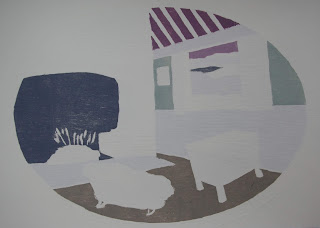Response to
The Waste Land
By LSA Leamington Studio Artists
An exhibition at East Lodge, Jephson Gardens, Leamington Spa
Curated by Karen Parker
Inspired by and in parallel with "Journeys with the Waste Land" an exhibition at the Herbert Art Gallery and Museum, Coventry.
The exhibition at East Lodge opened on 31st October and closes on 25th November.
I presented two woodcut prints for the exhibition
My title for the work is Dry bones can harm no one
For this exhibition artists were invited to create a piece of art to resonate with a particular aspect of T. S. Eliot's poem The Waste Land, in whatever medium they chose.
The aspect of the poem that intrigues me the most is in the final part What the Thunder Said, in particular, line 377: "A woman drew her long black hair out tight......" and line 390: "Dry bones can harm no one."
In between these two lines are references to "bats with baby faces," and "empty chapel" with "no windows."

































